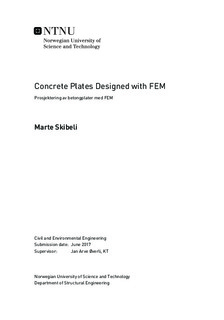Concrete Plates Designed with FEM - Prosjektering av betongplater med FEM
Master thesis
Permanent lenke
http://hdl.handle.net/11250/2454104Utgivelsesdato
2017Metadata
Vis full innførselSamlinger
Sammendrag
Most engineering companies design plates by use of finite element programs that areentirely automated. The program decides the element type, the meshing, and performsall the calculations. Often, the automatic procedure is hidden for the user, and it'sdifficult for the engineer to verify that the analysis is done correctly. Therefore, the goalof this thesis is to describe how concrete plates should be modelled in commercial designsoftware, and how a selection of design programs perform the automatic design procedure.The focus has been on plates subjected primarily to bending in both the Ultimate LimitState (ULS) and in the Serviceability Limit State (SLS).When modelling a plate, the element type and mesh are often defined automatically bythe software while the boundary conditions need to be specifed by the user. It is normallyrecommended to use pinned support at the centre of columns or walls, because it avoidsunintended rotational restraint. It is, however, also possible to model more realistically,with spring supports, if: The stress distribution over the support is of interest The rotational restraint from the support is of importance for the stresses in theplate.The theory background and manuals for a chosen set of design programs were examinedto figure out how the automatic design procedure for concrete plates can be carried out.The main problem of plate design is that, in contrast to simple beam theory, plates alsocontain twisting moments. This causes the reinforcement and the principal moments tobe in different directions. The main steps of the design procedure in ULS are to rotatethe stress resultants to the directions of the reinforcement, and then calculate either thedesign moments, or imaginary in-plane forces. These forces are then used to find therequired reinforcement for the upper and lower layer of the plate.An essential difference between the programs is the assumptions for the stress distributionin the cross section, and the internal lever arm. The programs are also separated by theway they define the crack angle. Normally, the crack angle is assumed to be 45 degrees in order to achieve a minimum amount of reinforcement. If, however, only one reinforcementdirection is needed, the optimal crack angle is no longer 45 degrees. In that case, some of the programs, like "FEM design", calculates a new optimal crack angle.In SLS, the programs differ in the way the stiffness reduction due to cracks is accountedfor. One alternative is to reduce the stiffness locally in elements where the concrete iscracked. Another alternative is to give the whole plate a reduced stiffness to achieve asmooth deformation pattern. The crack width is controlled by either of the following twoapproaches: Direct calculation of the crack width, and comparing this with the maximum allowedwidth Indirect calculation where the diameter and spacing of the reinforcement bars arecontrolled against tabulated maximum values
